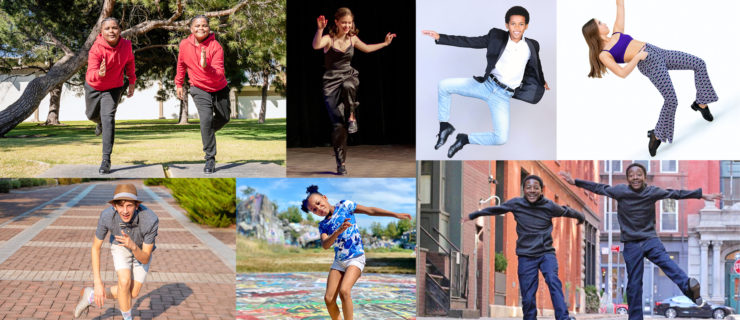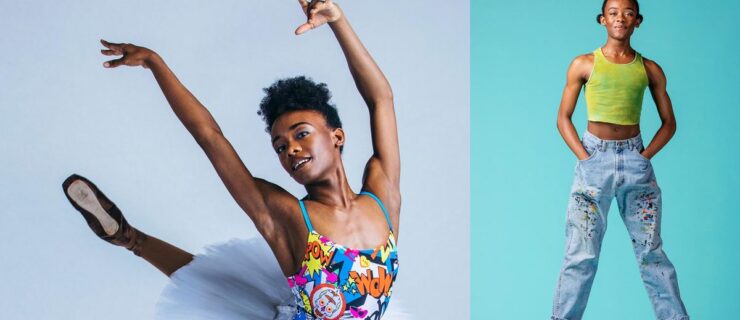How Commercial Phenom Amanda LaCount Is #BreakingtheStereotype
Amanda LaCount
was born to move. The second the music comes on at her Dance Spirit cover shoot, the bubbly 17-year-old is shimmying her shoulders and tossing her hair. When she launches into a full-out freestyle to Whitney Houston’s “It’s Not Right But It’s Okay,” you can’t take your eyes off her.
And yet with every gig she lands, Amanda is challenging some of the dance world’s longest-held biases. “I’m curvy,” she says, “and I like being curvy. My body is not a bad thing. It’s who I am.” Here’s how Amanda went from talented tot to hardworking pro—and from insecure preteen to body-positive role model.
Your browser does not support the video tag.
Finding Her Passion
Amanda started in ballet, tap, and jazz combo classes at age 2 at Mary Constantine-Nelson Dance Centre in Fort Collins, CO, and later added hip hop and other styles. Dance was a big part of her childhood, but it was far from her only extracurricular. She also took voice lessons and did regional theater. She qualified to compete at Nationals as a figure skater and was a competitive all-star cheerleader. She even rode horses.
Her early dance teachers saw a natural performer. “At 8 or 9 years old, she could command the stage,” says Jenni Leinweber, artistic director of Loveland Dance Academy in Loveland, CO, where Amanda trained after MCNDC. Leinweber also recalls Amanda having another special skill: “I could show her a minute of choreography once, and she’d get it all. I could not believe how accurate her memory was.”
 (photo by Jim Lafferty)
(photo by Jim Lafferty)
Unfortunately, not everyone was so supportive. After leaving LDA in search of a more challenging environment, Amanda spent a year at a prestigious competition school. She had a stellar season and thought she’d found her new dance home. Then she and her mom were called into a meeting with the studio owner. “He told me that my body type didn’t fit his vision,” Amanda remembers. “I was sad and traumatized. That was the first point where I realized, ‘I’m different. I’m going to have to fight to be taken seriously.’ ”
Your browser does not support the video tag.
Making Bold Moves
In 2013, Amanda joined the L.A.-based kids dance crew Latin Flavah. She and her mom committed to driving back and forth from Colorado to California so she could train and perform alongside other hip-hop up-and-comers, like Jordyn Jones, Kaycee Rice, and Tati McQuay. “It was such a great experience—except for the 16-hour trip every weekend,” Amanda says.
When the travel eventually became too much, it was decision time. “I knew I wanted to be a professional dancer,” Amanda says. “Everyone moves to L.A. after high school. I thought, ‘What if I came out here while I was younger? I could start making a name for myself before I turned 18.’ ” In January 2015, she arrived in the City of Angels and hit the ground running. In addition to enrolling at Champs Charter High School of the Arts, she started studying at Millennium Dance Complex, EDGE Performing Arts Center, IDA Hollywood, and Playground LA. She also signed with Bloc Talent Agency. Soon, she was being sent to three or four auditions a week.
 (photo by Jim Lafferty)
(photo by Jim Lafferty)
The transition wasn’t without its setbacks. For example, when 14-year-old Amanda met fitness guru Richard Simmons on a red carpet, he offered her some unsolicited advice: Lose 15 to 20 pounds in order to make it in the entertainment industry. “I walked away sobbing,” she says. “I thought, ‘Should I just go home now?’ ”
But she kept training, and auditioning. “I learned where to stand, what to wear, how to freestyle, how to catch the casting director’s eye,” she says. It took about six months to land her first gig, a J.C. Penney commercial. “Getting that stamp of approval from someone in the industry gave me confidence,” Amanda says. “I realized there was nothing holding me back.”
Becoming a Pro
Amanda’s unique look is far from the only thing she brings to the table. She describes her movement style as being “in the sweet spot between hard-hitting and lyrical,” and cites her vulnerability and storytelling as other strengths. “When I dance, I’m an open book,” she says. “I don’t fake emotion. It’s truly from the heart.”
People in the industry have taken notice. Amanda has performed on “The Voice” and “Dancing with the Stars.” She was featured in Katy Perry’s “Swish Swish” music video—chosen by Perry herself, out of thousands of entries in an Instagram dance contest. She spent two years on the WNBA Los Angeles Sparks Crew, is regularly featured in class videos for popular teachers like Matt Steffanina, is a member of Chloe and Maud Arnold’s youth tap company #NoFilter: Sole Talk, and is a Team Capezio brand ambassador.
 (photo by Jim Lafferty)
(photo by Jim Lafferty)
In 2018 alone, Amanda has crossed off two of the biggest goals on her career bucket list: performing on “The Ellen DeGeneres Show,” with The Greatest Showman’s Keala Settle, and dancing for Meghan Trainor at the Radio Disney Music Awards. The latter experience, in June, was particularly special: “Meghan’s song ‘All About That Bass’ helped me love my body,” Amanda says.
“Amanda wears her curves with pride, and I love that, but she’s also an incredibly dynamic dancer who can do anything that’s asked of her,” says Brian Friedman, whom Amanda considers a mentor. The two first met in one of Friedman’s L.A. master classes. “I’ve noticed so much growth in her,” he says. “My class demands versatility, and she brings it.” Recently, Friedman has been encouraging Amanda to train more in heels. To push her, he cast her in former Pussycat Doll Carmit Bachar’s “How Far” music video—the youngest of the shoot’s 40 women.
Paying It Forward
These days, Amanda stays busy with auditions, jobs, classes, and travel while also studying full-time at Los Angeles Valley College. She dreams of going on tour with a big-name artist, and of becoming known as a choreographer and teacher in her own right. But no matter where her career takes her, one of the things she’s proudest of is facing the dance world’s body prejudices head-on.
To help others find the confidence she’s worked so hard to develop in herself, she launched a social media hashtag campaign, #breakingthestereotype, in 2016. “I want to show people you don’t have to look a certain way to be a good dancer and be successful,” she says. Amanda shares dance videos almost daily on her super-popular Instagram (at press time, she had 141,000 followers), and tries to respond to every direct message and like every comment. “My posts are inspiring people, which is wonderful, but it can be a lot of pressure,” she says. “But I wouldn’t be where I am without everyone’s support. I have to show my followers how much I appreciate them.”
Like anyone in the public eye, she’s dealt with haters. “I try to ignore them, because confronting them would only add fuel to their fire,” she says. It helps that for every negative comment, there are hundreds of nice ones. Meanwhile, with each share, #breakingthestereotype reaches more people—dancers and non-dancers alike.
“It’s so easy to focus on what other people think about you, rather than how you feel about yourself,” Amanda says. “But you only have one life. I want to tell people: If you love something, do it! It’s as simple as that.”
Amanda would like to dedicate this story to her dad, Joedy Krieg, who passed away November 15, 2015.
A version of this story appeared in the November 2018 issue of
Dance Spirit with the title “Dancing Outside the Lines.”



